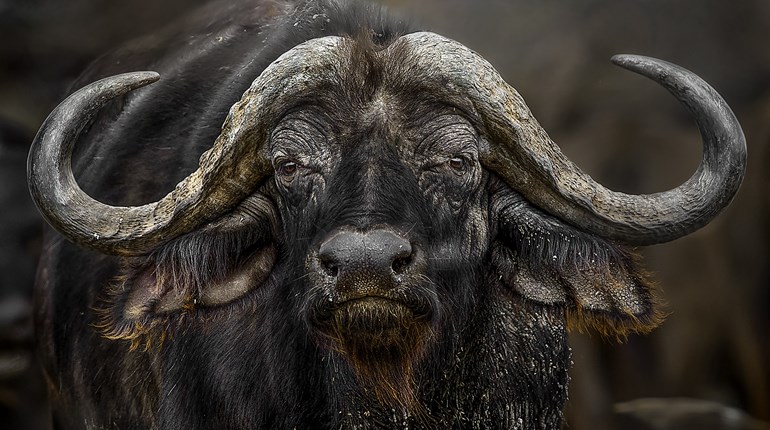
There is no separating guns from politics in this “woke” age of political purity tests. Though many of us would like to enjoy a movie, and thereby step away for a lovely 90 minutes from the unfortunate reality that our basic constitutional rights are under constant attack, Hollywood won’t let us.
Most recently, a group of movie stars—well, many of them has-beens—such as Amy Schumer, Rosie O’Donnell, Daryl Hannah, Chelsea Handler, Alyssa Milano, Ben Platt, Eric McCormack and Julianne Moore, publicly tried to shame the few film executives in Hollywood who dare to support politicians who vote to protect our Second Amendment freedoms.
These actors published an open letter just before the Academy Awards last February saying that anyone who contributes to candidates who “take money from the NRA and vote against gun reform” has blood on their hands. According to the letter, since 2016, studio’s political action committees have donated $4.2 million to “NRA-backed lawmakers.”
“These lawmakers’ opposition to gun reform is literally putting our audiences in danger and we are urging you to consider a politician’s position on gun reform when [making] political contributions in the future,” said these actors.
It is hard to even feign surprise that the letter, according to Variety, was “crafted with the help of gun reform advocacy group Guns Down America,” a gun-control group that’s all in with “cancel culture.”
Now, you’re probably shaking your head and thinking Hollywood hypocrites; actors, after all, often glorify guns in film but then demonize America’s large and very law-abiding gun culture in public appearances.
Even many of the actors who signed this letter are trying to have it both ways. Amy Schumer actually used a semi-automatic pistol in “Snatched” (2017) to stop a bad guy from killing her character. Alyssa Milano got a big boost early in her career in the action film “Commando” (1985), a movie in which Arnold Schwarzenegger stacked up so many bodies critics mocked it. Daryl Hannah had guns in her hands in the “Kill Bill” franchise and in the awful flick “Zombie Night” (2013).
They might argue that their art doesn’t parallel real life, but the thing is, it does. The guns showcased in movies are often owned and possibly carried by American citizens. People use these firearms for sport and self-defense every day.
To be fair, artists push boundaries, which, in this case, means pushing away from conformity. And, legally speaking, nothing conforms America more than our Constitution. Still, Hollywood is also caught in a deeper current. Our Second Amendment protects an individual right; this is the enshrinement of a core American value that is itself freeing, empowering, individualistic and in sync with the great American experiment, as individual rights are a check on the state. Still, this current is conservative by definition, as the word “conservative” comes from the Latin “conservare,” or to preserve; in this case, this means it conserves a constitutional right. But, once again, the right to keep and bear arms is forever freeing and always filled with the potential for any good individual to boldly stand for life, liberty and the American way.
Actually, without the individualism protected by the Second Amendment of the U.S. Bill of Rights, Hollywood would lose classic characters like the gunslinger with the white hat—think Gary Cooper in “High Noon” (1952), a marshal told to leave who nevertheless stands alone against a gang of bad guys—or Clint Eastwood’s “Dirty Harry” (1971), a cop willing to defy a corrupt bureaucracy in order to get the bad guy preying on innocents.
Without the individualistic good-guy-with-a-gun part, those characters, indeed most heroic storytelling, would be off-limits. In that case, Hollywood denizens would cede the action genre to their dishonest, unthinking politics. “Dishonest” because they’d actually be giving up their liberal bona fides, as the individual would then lose his or her individuality, in essence and literally, as he or she would no longer be an individual, but just a pawn of the bureaucracy. This is “unthinking” because they wouldn’t be capable of understanding what used to be called “American exceptionalism.”
Such are the contradictions the Hollywood of today just can’t be honest about, as it runs counter to their shallow politics.
Still, there’s hope. Some modern films—the “John Wick” franchise, for example—have been free of politics. And regardless, as much as some Hollywood actors and executives want to influence America’s culture of freedom, even to turn it into something they can use but you can’t have, they are in reality heavily influenced by the big, real gun culture that is so mainstream across this nation that more than 100 million Americans legally participate in it. The tail, no matter how hard Hollywood tries, just can’t wag the dog.
As guns and our Second Amendment freedom are fundamental parts of America, new firearms models actually show how guns, with Hollywood roles being a part, have always been literal and symbolic expressions of the freedom some in Hollywood want to both use and diminish.
To see this more clearly, here is a list of specific examples of guns that have shaped American culture; guns that Hollywood couldn’t resist; guns that are iconic and a lot of fun to shoot.

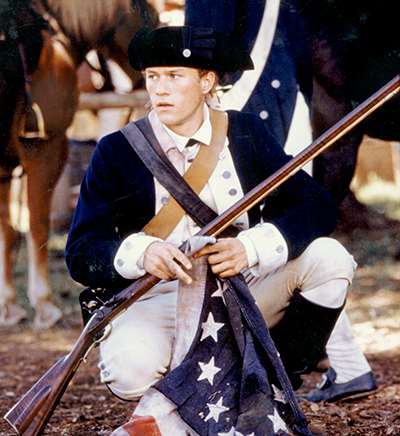
Flintlock Longrifle
Before the advent of Italian replica firearms in the 1960s, if you saw an antique firearm on the screen, it was probably an original. Cecil B. DeMille was known to have an extensive personal collection that he frequently loaned for various productions. In the case of this beautiful longrifle, it is an original made by Martin Smith in 1816 in Lancaster, Pa. This rifle (A) was carried by Charlton Heston as Capt. William Clark in “The Far Horizons” (1955). It was also used by John Wayne in “Allegheny Uprising” (1939), by Gary Cooper in “The Unconquered” (1947) and in John Wayne’s “The Alamo” (1960).
“The Patriot” (2000) re-kindled American interest in the events and personalities of the American Revolution. Mel Gibson played the reluctant hero Col. Benjamin “The Ghost” Martin and Heath Ledger, his oldest son, Cpl. Gabriel Martin. Gibson’s gun is a silver-mounted longrifle (B) of the Tidewater style made by Frank House of Kentucky. It bears the initials of Gibson’s character, “BM,” on the patch box and a 13-pointed star inletted into the left stock that is inscribed with the motto: “We are one.” Legder’s rifle (C) has a wooden patch box and was one of many made by Jim Chambers for Heath and carried by him in the film.
Ryder
Four decades ago, the Smithsonian’s National Museum of American History opened a temporary exhibit billed “Hollywood: Legend and Reality.” Walking through the exhibit hall, I was immediately drawn toward a six-foot exhibit case that contained a black Stetson hat, leather vest, nickel-plated single-action Colt in a gun belt and a set of polished boots.
A marshal’s badge on the vest and the ceiling-to-floor black-and-white photo of a deserted main street in a nameless cow town were a giveaway that the ensemble was from Gary Cooper’s 1952 classic portrayal of Marshal Will Kane in the movie “High Noon.” Just standing in front of those props and seeing the marshal’s badge nearly brought tears to my eyes. I was ecstatic to be in such proximity to icons of Hollywood films.
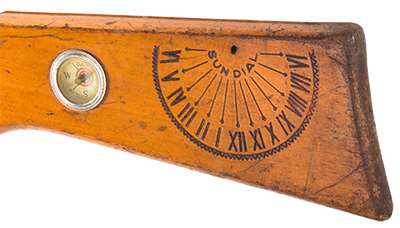
It was a feeling I shared with Ralphie Parker of Cleveland, Ohio, in 1983’s “Christmas Story.” Jean Shepherd described Ralphie’s emotions so eloquently when he first saw a BB gun in a store window: “Wow, there it is. The holy grail of Christmas gifts. The Red Ryder 200-shot range model ... air rifle.” And who can’t relate to his thoughts as he curled up under the blankets on Christmas night reflecting that “next to me in the blackness lay my oiled blue-steel beauty. The greatest Christmas gift I had ever received, or would ever receive. Gradually, I drifted off to sleep, pranging ducks on the wing and getting off spectacular hip shots.”
To the frustration of collectors everywhere, a Red Ryder as described, doesn’t exist, or at least was not a model offered by Daisy at the time of the film’s setting. What did have a compass and sundial was the less-well-known but earlier model named for Buck Jones. Daisy’s factory in Plymouth, Mich., manufactured several youth air gun models named after screen stars that predated the Red Ryder. A true-life and movie hero, Buck Jones served in the Pershing Punitive Expedition in Mexico in 1916 and worked on the famous Miller Brothers 101 Ranch before working in films with such notables as Tom Mix. Jones soon became a star in his own right and at one point was the most popular star in Hollywood. He died in November 1942 while attempting to rescue patrons of the Coconut Grove Theater in Boston, Mass., during the tragic fire that claimed hundreds of lives.

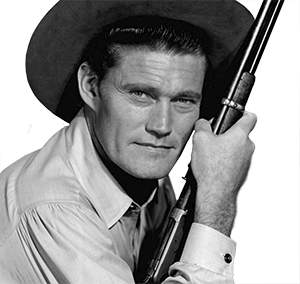
Winchester Model 1892 Carbine
Chuck Connors starred as Lucas McCain in the popular TV series “The Rifleman” (1958-1963) with the Winchester Model 1892. Several Winchester carbines were modified and used during the six-year, 168-episode production run of “The Rifleman,” which aired weekly on ABC. The Rifleman used a modified Winchester Model 1892 rifle; it had a large lever that was drilled and tapped for a set screw. The lever design allowed him to cock the rifle by spinning it around his hand. In addition, the screw could be positioned to depress the trigger every time he worked the lever, allowing for rapid fire. He emptied the rifle’s tubular magazine in under five seconds during the opening credits. The large loop rifle is also associated with John Wayne, who used a .44-40 Winchester 92 version in many films.

M-16 Carbine
This is the M-16, as used by Mel Gibson in “We Were Soldiers” (2002). The 1965 battle for the Ia Drang Valley was portrayed in the movie.Gibson used this M-16 with great effectiveness throughout the film.
This rifle had a rocky beginning and was derided by many of the soldiers who first received them while fighting in southeast Asia during the Vietnam conflict.
The M-16 led to a different but similar rifle, the AR-15, which was actually first sold to American citizens at the same time the U.S. military was first purchasing M-16s. The AR-15, and its derivatives, are now so popular that Americans own more than 17 million of them.
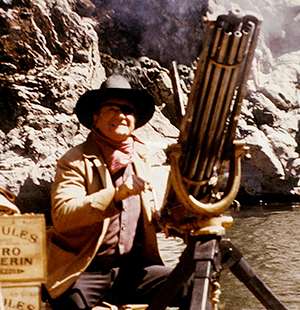
Model 1890 Gatling Gun
At almost any time when westerns or other films required the shooting of a Gatling gun, this original Colt-made example came into play. John Wayne’s rapid-fire sequence atop a raft in “Rooster Cogburn” (1975) is just one of many films where this Gatling was the actual gun fired on screen. The top-feeding box magazine is blocked to feed blank .45-70 cartridges.

Colt Walker
These guns represent working reproductions and rubber guns made for Clint Eastwood’s use in the film “The Outlaw Josey Wales” (1976). The Italian reproductions of the famous Colt Walker were made in 1962 and since the filming of the movie in 1976, they have been converted to fire blank cartridge ammunition. The rubber guns (A) were made from one of the original Italian copies (#954) and were used as “stunt doubles” when the originals would have been exposed to damage. Additionally, the original Walkers weighed over 4.5 pounds and the lightweight rubber guns enabled the principal actor to fast-draw and spin these guns with ease through numerous camera takes.
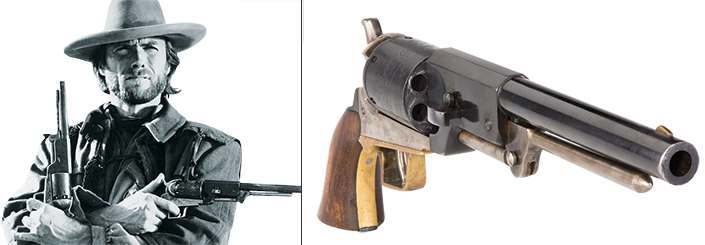
As most of the firearms illustrated here came from Hollywood prop houses, it was not uncommon for one gun to be rented and used in numerous other films. These Colt Walker Revolvers were also used in the 1969 John Wayne classic “True Grit.” This Italian-made reproduction of a Colt Walker (B) had its own scene in the film when John Wayne, as Marshall Cogburn, first meets Kim Darby’s character, Mattie Ross.
Rooster Cogburn: Why, by God, girl, that’s a Colt’s Dragoon! You’re no bigger than a corn nubbin, what’re you doing with all this pistol?
Mattie Ross: It belonged to my father, he carried it bravely in the war, and I intend to kill Tom Chaney with it if the law fails to do so.
Rooster Cogburn: Well, this’ll sure get the job done if you can find a fence post to rest it on while you take aim.

Hawken Plains Rifle
Charlton Heston starred as “Bill Tyler” in “The Mountain Men” (1980)—his co-star, a Hawken. While not one of the primary rifles used for close-ups, this rifle was one of many dozens used for stunts and double work. “The Mountain Men” was just one of a number of films featuring frontier mountain men in the late 70s and early 80s. “Man in the Wilderness” (1971) and “Jeremiah Johnson” (1972) helped develop interest in living-history programs that resulted in the Eastern Rendezvous and similar events that attract tens of thousands of participants.
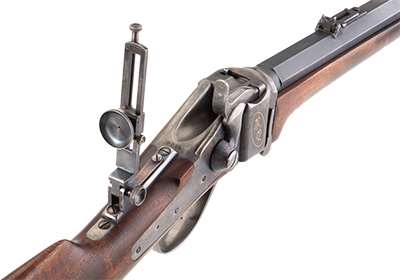
Sharps #3 Rifle
Tom Selleck starred as Matthew Quigley in the now-classic film “Quigley Down Under” (1990), and this rifle was one of three made for use in the film. It bears the initials of Selleck’s character, Matthew Quigley, inlaid in gold on the receiver. Manufactured by Shiloh Sharps Co., a “Quigley Sharps” will still require a year or two of waiting due to its never-diminishing popularity.
National Firearms Museum
In an attempt to relate to, and capture the spirit of the films and shows we enjoyed so much, The NRA Museum has mounted three exhibits at the National Firearms Museum in Fairfax, Va., as well as the National Sporting Arms Museum in Springfield, Mo., that feature the wide variety of firearms used in film and television over the years. Here you can see “Dirty Harry’s” revolver, some of the lever-action rifles John Wayne used in films and much more. (nramuseum.org)














